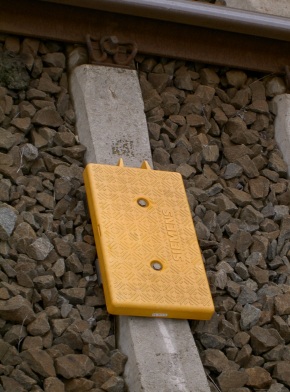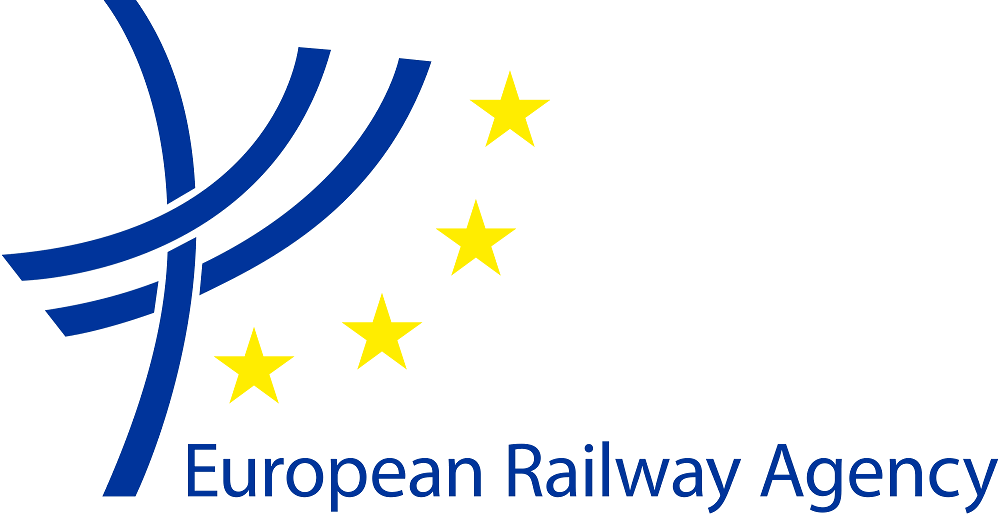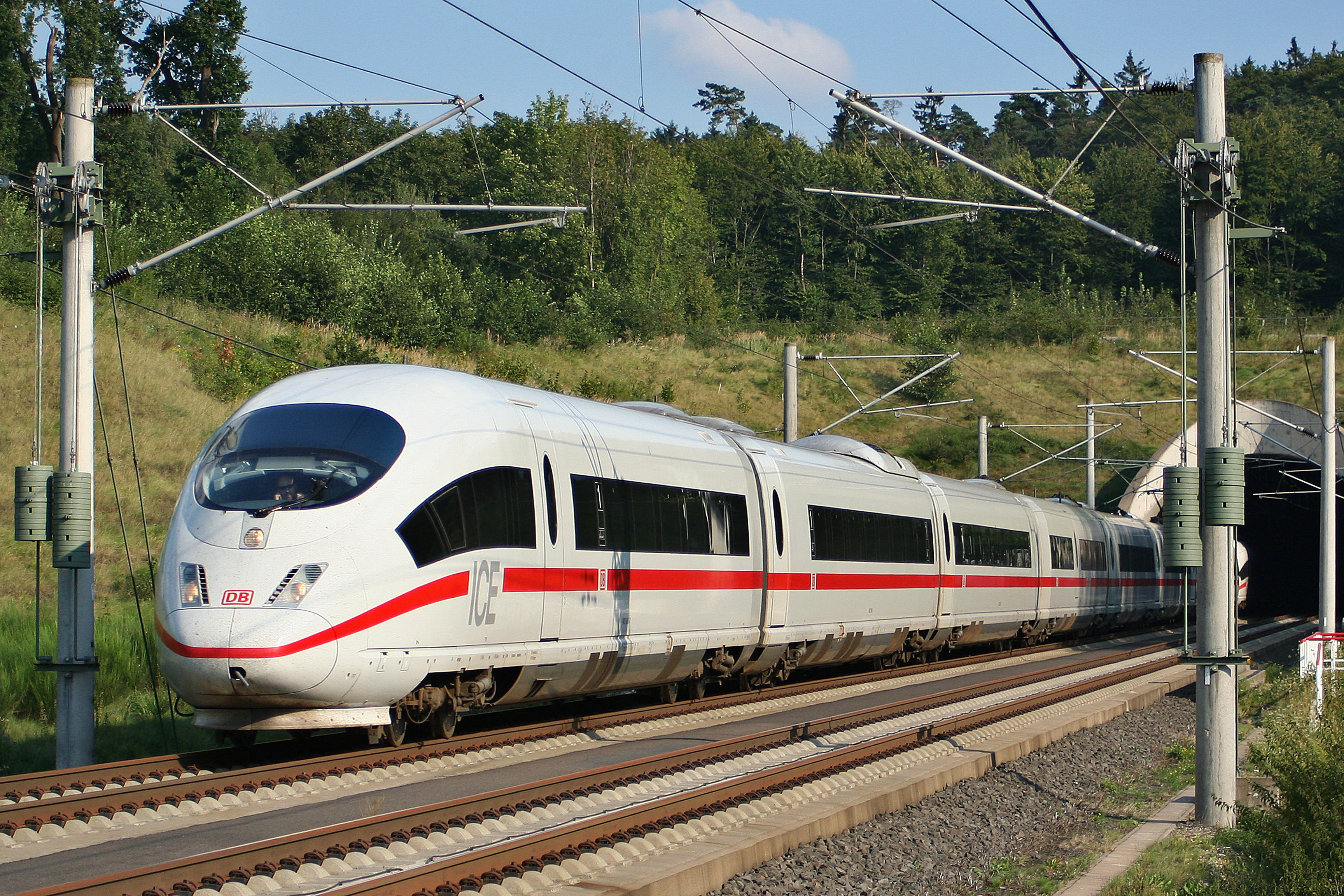|
ETCS
The European Train Control System (ETCS) is a train protection system designed to replace the many incompatible systems used by European railways, and railways outside of Europe. ETCS is the signalling and control component of the European Rail Traffic Management System (ERTMS). ETCS consists of 2 major parts: #trackside equipment #on-board (on train) equipment ETCS can allow all trackside information to be passed to the driver cab, removing the need for trackside signals. This is the foundation for future automatic train operation (ATO). Trackside equipment aims to exchange information with the vehicle for safely supervising train circulation. The information exchanged between track and trains can be either continuous or intermittent according to the ERTMS/ETCS level of application and to the nature of the information itself. The need for a system like ETCS stems from more and longer running trains resulting from economic integration of the European Union (EU) and the ... [...More Info...] [...Related Items...] OR: [Wikipedia] [Google] [Baidu] |
European Rail Traffic Management System
The European Rail Traffic Management System (ERTMS) is the system of standards for management and interoperation of signalling for railways by the European Union (EU). It is conducted by the European Union Agency for Railways (ERA) and is the organisational umbrella for the separately managed parts of * GSM–R (communication), * European Train Control System (ETCS, signalling), * European Train Management Layer (ETML, payload management) The main target of ERTMS is to promote the interoperability of trains in the EU. It aims to greatly enhance safety, increase efficiency of train transports and enhance cross-border interoperability of rail transport in Europe. This is done by replacing former national signalling equipment and operational procedures with a single new Europe-wide standard for train control and command systems. The development process was started with the technical foundations for communication (GSM-R) and signalling (ETCS). Both are well established and in ad ... [...More Info...] [...Related Items...] OR: [Wikipedia] [Google] [Baidu] |
Eurobalise
A Eurobalise is a specific type of a balise installed between the rails of a railway. Eurobalises are part of the European Train Control System (ETCS). The balises are pre-programmed and contain information that is read by train antennas. One of their many functions is to allow a train to determine its location. Overview A balise typically needs no wayside power source. Coupling between the balise and the vehicle-mounted antenna is by magnetic induction, similar to a transformer - although operating at frequencies typical of radio, it is not a radio system. In response to "telepowering" by means of a 27 MHz, CW-modulated magnetic field transmitted by a (BTM and its associated antenna) mounted under a passing train, the balise transmits information to the train (''uplink'') by means of a 4.234 MHz FSK-modulated magnetic field. The original provisions for Eurobalises to receive information from the train (''downlink'') have been removed from the specification. The tra ... [...More Info...] [...Related Items...] OR: [Wikipedia] [Google] [Baidu] |
Automatic Train Operation
Automatic train operation (ATO) is a method of operating trains automatically where the driver is not required or is required for supervision at most. Alternatively, ATO can be defined as a subsystem within the automatic train control, which performs any or all of functions like programmed stopping, speed adjusting, door operation, and similar otherwise assigned to the train operator. The degree of automation is indicated by the Grade of Automation (GoA), up to GoA4 in which the train is automatically controlled without any staff on board. On most systems for lower grades of automation up to GoA2, there is a driver present to mitigate risks associated with failures or emergencies. Driverless automation is primarily used on automated guideway transit systems where it is easier to ensure the safety due to isolated tracks. Fully automated trains for mainline railways are an area of research. The first driverless experiments in the history of train automation date back to 1920 ... [...More Info...] [...Related Items...] OR: [Wikipedia] [Google] [Baidu] |
GSM-R
GSM-R, Global System for Mobile Communications – Railway or GSM-Railway is an international wireless communications standard for railway communication and applications. A sub-system of European Rail Traffic Management System (ERTMS), it is used for communication between train and railway regulation control centers. The system is based on GSM and ''EIRENE – MORANE'' specifications which guarantee performance at speeds up to 500 km/h (310 mph), without any communication loss. GSM-R could be supplanted by LTE-R, with the first production implementation being in South Korea. However, LTE (telecommunication), LTE is generally considered to be a "4G" protocol, and the International Union of Railways, UIC's Future Railway Mobile Communication System (FRMCS) program is considering moving to something "5G"-based (specifically 3GPP R15/16, i.e. 5G NR), thus skipping two technological generations. History GSM-R is built on GSM technology, and benefits from the economie ... [...More Info...] [...Related Items...] OR: [Wikipedia] [Google] [Baidu] |
Integra-Signum
Integra-Signum is a Swiss train protection system introduced in 1933. Originally it was called Signum; the name Integra was added later. It transmits data inductively and is simple, robust and reliable also in snow. How it works The locomotives have three sending and receiving magnets and there are two trackside magnets near the signals. Integra-Signum requires the train driver to confirm distant signals that show stop and distant or home signals that show caution. If no confirmation is received or a home signal that shows stop is passed without authority, the train is stopped automatically. This is achieved by interrupting the power supply to the motors and applying the emergency brake. The locomotive's sending magnet is a strong permanent magnet, which induces a current in the receiving magnet in the middle of the track, if the signal's short-circuit contact is closed. The receiving magnet on the locomotive consists of two magnet field detectors, which detect the signal's sta ... [...More Info...] [...Related Items...] OR: [Wikipedia] [Google] [Baidu] |
European Union Agency For Railways
The European Union Agency for Railways (ERA) is an agency of the European Union (EU) that sets mandatory requirements for European railways and manufacturers in the form of Technical Specifications for Interoperability (TSI), which apply to the Trans-European Rail system. The ERA publishes a document summarising the status of the TSIs. The ERA sets common safety targets, common safety methods and common safety indicators, following Directive 2004/49/EC and amendments. The ERA also hosts a number of databases, among which a register of remaining, applicable national rules. One of its primary duties is the development and implementation of the European Rail Traffic Management System (ERTMS). History Prior to the establishment of the agency, the railway networks of each individual member state within the European Union had been unique and typically employing high levels of bespoke, self-developed working practices, rolling stock, and infrastructure; the requirements pertaining to ... [...More Info...] [...Related Items...] OR: [Wikipedia] [Google] [Baidu] |
Train Protection System
A train protection system is a railway technical installation to ensure safe operation in the event of human error. Development Train stops The earliest systems were train stops, as still used by the New York City Subway, the Toronto rapid transit, Toronto subway, the London Underground, the Moscow Subway (only on the older lines) and the Berlin S-Bahn. Beside every Railway signal, signal is a moveable arm. If the signal is red, levers connected to valves on any passing train hit the arm, opening the Air brake (rail), brake line, applying the emergency brake, If the signal shows green, the arm is turned away from the levers and there is no contact. The Great Western Railway in the UK introduced its 'automatic train control#United Kingdom, automatic train control' system in the early years of the 20th century. Each distant signal had before it a ramp between the running rails. If the signal showed green, the ramp was energised with a low voltage current which was passed to ... [...More Info...] [...Related Items...] OR: [Wikipedia] [Google] [Baidu] |
Alstom
Alstom SA () is a French multinational rolling stock manufacturer which operates worldwide in rail transport markets. It is active in the fields of passenger transportation, signaling, and locomotives, producing high-speed, suburban, regional and urban trains along with trams. The company and its name (originally spelled Alsthom) was formed by a merger between the electric engineering division of Société Alsacienne de Constructions Mécaniques (Als) and Compagnie Française Thomson-Houston (thom) in 1928. Significant acquisitions later included the Constructions Électriques de France (1932), shipbuilder Chantiers de l'Atlantique (1976), and parts of ACEC (late 1980s). A merger with parts of the British General Electric Company formed GEC Alsthom in 1989. Throughout the 1990s, the company expanded its holdings in the rail sector, acquiring German rolling stock manufacturer Linke-Hofmann-Busch and Italian rail signaling specialist Sasib Railways. In 1998, GEC Alsthom was ... [...More Info...] [...Related Items...] OR: [Wikipedia] [Google] [Baidu] |
Sistema Controllo Marcia Treno
Sistema di Controllo della Marcia del Treno (SCMT) is a discontinuous train cab signalling system used in Italy. It shares many features with the Ripetizione Segnali (RS) system, the two systems co-existing and working together. The main purpose of SCMT is to control the respect of the speed limit imposed by the signal aspect and the line condition. SCMT is divided in two parts: *SSB: ''Sottosistema di bordo'' ("Onboard Subsystem") *SST: ''Sottosistema di terra'' ("Ground Subsystem") Working principles SCMT is based upon an array of transponders called "Punto informativo" (PI) placed on the tracks near signals, reduced speed zones, and other important points along the line. The PIs form the SST. When a train passes over a PI, a set of "antennas" mounted in front of the first bogie energize it through induction. The PI then passes information about the aspect of the next signal through the antennas to the SSB. If the system is supported by RS, and if the signal shows a ... [...More Info...] [...Related Items...] OR: [Wikipedia] [Google] [Baidu] |
European Commission
The European Commission (EC) is the primary Executive (government), executive arm of the European Union (EU). It operates as a cabinet government, with a number of European Commissioner, members of the Commission (directorial system, informally known as "commissioners") corresponding to two thirds of the number of Member state of the European Union, member states, unless the European Council, acting unanimously, decides to alter this number. The current number of commissioners is 27, including the president. It includes an administrative body of about 32,000 European civil servants. The commission is divided into departments known as Directorate-General, Directorates-General (DGs) that can be likened to departments or Ministry (government department), ministries each headed by a director-general who is responsible to a commissioner. Currently, there is one member per European Union member state, member state, but members are bound by their oath of office to represent the genera ... [...More Info...] [...Related Items...] OR: [Wikipedia] [Google] [Baidu] |
Deutsche Bahn
(, ; abbreviated as DB or DB AG ) is the national railway company of Germany, and a state-owned enterprise under the control of the German government. Headquartered in the Bahntower in Berlin, it is a joint-stock company ( AG). DB was founded after the merger between Deutsche Bundesbahn and the East German Deutsche Reichsbahn in 1994 after the unification of Germany and has been operating ever since. is the second-largest transport company in Germany, after the German postal and logistics company / DHL. DB provides both long-distance and regional transport, serving around 132 million long distance passengers and 1.6 billion regional passengers in 2022. In 2022, DB transported 222 million tons of cargo. Company profile The group is divided into several companies, including '' DB Fernverkehr'' (long-distance passenger), '' DB Regio'' (local passenger services) and '' DB Cargo'' (rail freight). The Group subsidiary '' DB InfraGO'' also operates large parts of the German ... [...More Info...] [...Related Items...] OR: [Wikipedia] [Google] [Baidu] |





